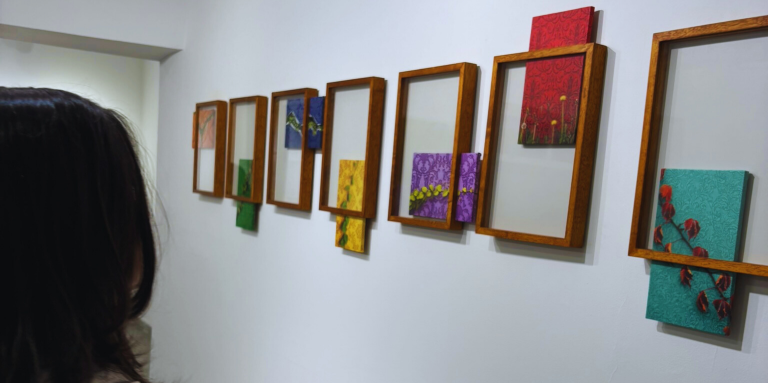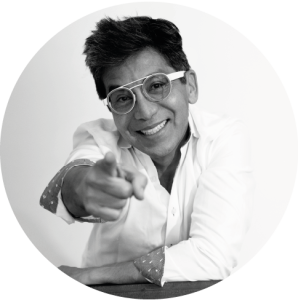
Pop Up 107: A Collaborative Exhibition Redefining Artistic Freedom
Pop Up 107 in Bogotá showcases new and returning works from six The Art Dome artists, redefining artistic freedom and collaboration.

A ceramic mushroom shattered on the floor of Antonio Puri’s Bogotá studio. We both paused. There was something ritual in the silence that followed — as if the universe had spoken in fragments.
Antonio, born in Chandigarh, in northern India, told me about a childhood memory. “They used to say I had a black tongue,” he said, half-smiling. “Because the things I said came true.” That fear of superstition — of words manifesting reality — became the seed of one of his most powerful series: Lengua Negra. It is a meditation on the power of words, belief, and the fine line between manifestation and fear.
Yesterday, I had the chance to visit Antonio’s studio in Bogotá. It was a rare and unforgettable experience: he is in the process of closing an eight-year chapter in Colombia, and sharing that moment with him felt almost like witnessing an intimate ceremony of transition. Until just a few days ago, I only knew his work on a surface level. But walking into his studio felt like entering a different universe — one full of strength, symbolism, and truth.
Antonio is a prolific artist who, after years of exhibiting internationally, chose Colombia as a space for creation. Here, in the midst of a vibrant and culturally rich environment, he developed a monumental body of work that reflects not only technical evolution, but also a deep inner journey. His work is marked by commitment, intention, and a constant search for meaning.


During our conversation, Antonio shared more than anecdotes — he shared his truth. In his words, “It’s difficult, the life of an artist.” After 23 years of building a career, exhibiting around the world, and being part of important collections, he still feels that the art world can be unpredictable, even ungrateful. Yet, he remains rooted in the belief that “art is not talent — it is soul, intention… there is beauty in that.”
The path of an artist, he explained, does not follow a predictable trajectory like other professions. An artist might have museum shows, critical acclaim, and yet still face uncertainty. Artistic careers are not always measured by visible milestones, but by the capacity to resist, reinvent, and keep creating — even in silence.
One of the most powerful moments he recounted was after the September 11 attacks in New York. He cut up completed works and turned them into two towers — a symbolic gesture of both destruction and reconstruction. Since then, his art has become even more visceral, charged with intention.
Many of his works are massive canvases, almost architectural structures, designed not only to inhabit space but to transform it. Some of his proposals imagine the museum as a structure literally supported by the paintings: art as the pillar of culture.
His studio in Bogotá is an extension of his thinking: a vast space, filled with giant jars of sequins, stacks of canvases, diverse materials, and a surgical-level of order that contrasts with the energy vibrating in every corner. We shared a chai tea with ginger, prepared over fire on a stone stove. It felt sacred — a moment of presence and quiet understanding.
Antonio shared a paradox faced by many contemporary artists: he once spoke with a fellow artist, and both realized they couldn’t afford their own work. His friend told him, “It doesn’t matter — you may not be able to buy yours, but you can trade it for mine.” That exchange, far from traditional commerce, became a form of mutual recognition and the beginning of his personal collection. It echoes the stories of artists throughout history who traded works not as commodities, but as gestures of community.
He draws inspiration from artists like Kiefer, Kapoor, Cecily Brown, and Ghada Amer — creators who challenge labels and explore new terrain. In music, he turns to spiritual traditions, especially the mystical resonance of Nusrat Fateh Ali Khan.
Much of his production has now been shipped to the United States. Antonio is preparing to close this chapter with a move back to Florida, where the next stage of his journey awaits. He also mentioned plans for a future trip to Thailand — a pause he looks forward to as a time to decompress and reflect.
Among his remaining canvases, some may still be completed in these final days in Bogotá. Others he plans to leave behind for local artists. His studio is not just a place of creation — it’s a legacy left open for others to continue.
At The Art Dome, we believe in sharing stories that inspire. Stories that speak of art, yes, but also of humanity. And this is one of them.
We are preparing a visual editorial about Antonio. We’d love to include images of his most representative installations and projects, with the aim of showcasing the magnitude, power, and beauty of his work. Additionally, we believe Antonio’s monumental works — with their scale, energy, and narrative force — are ideally suited for large architectural spaces. From corporate lobbies to institutional walls, his canvases have the power to transform not just interiors, but the energy of a space itself.
At The Art Dome, we envision collaborating with companies and institutions to install his large-scale works as part of our corporate art collections, creating environments that inspire reflection, identity, and emotional connection. — bringing powerful messages into spaces where art transforms daily life.
This article is just a first look — an invitation to follow the journey of an artist who creates from the soul, and who reminds us that true art is not measured in sales or trends, but in its power to move, to transform, and to endure.

Art transforms spaces, inspires teams, engages clients, and strengthens reputation while creating long-term cultural value.
Yes. We create curated art collections that represent your brand’s identity and connect it with culture and innovation.
You can apply to our residency and acceleration programs. We guide artists with mentorship, visibility, and international connections
PARAGRAPH 3 Bio 
Pop Up 107 in Bogotá showcases new and returning works from six The Art Dome artists, redefining artistic freedom and collaboration.

At The Art Dome, we believe art and design aren’t just disciplines — they’re collaborators. After a successful partnership with Eichholtz, we’re reimagining our showroom and inviting designers to explore how art can elevate, enrich, and inspire interior spaces. Join us as we bridge creativity and utility in exciting new ways.

As a way to expand and use our many online platforms, we invite you to dive deep into our first virtual showroom at Artsy, allowing you to experience Cube, an exposition of recent works done by Art Dome artist Camilo Bojáca.